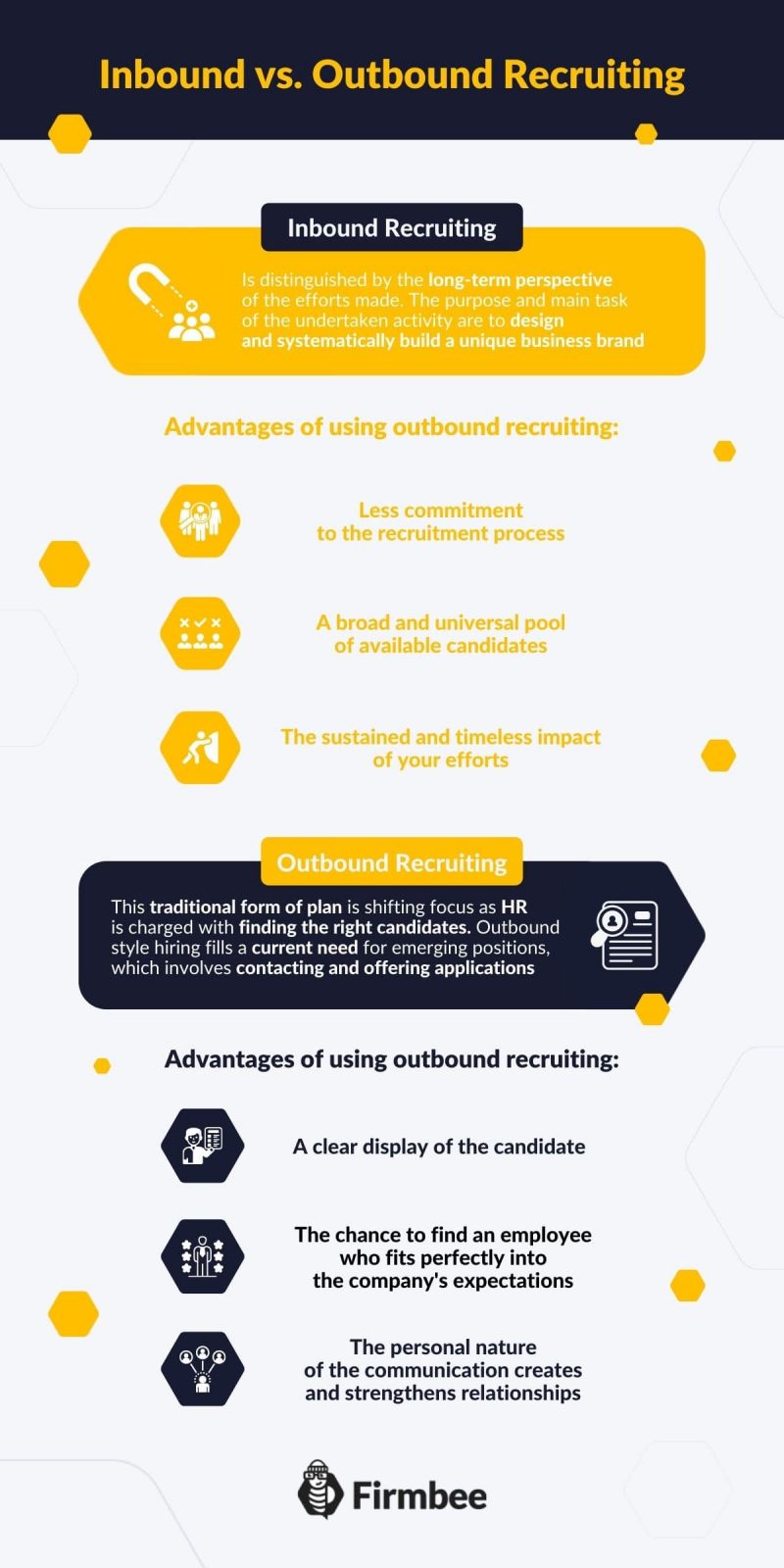The engagement of true professionals is the backbone of all successful companies. It is the human resources department that is responsible for establishing valuable partnerships, and it uses two strategies to do so. These are Inbound recruiting and Outbound recruiting techniques. Each features different priorities and specifics, but the goal is common – to recruit the best candidates. What is the difference between the two? Which form will work in your organization? Take a look at our article to find out!
Inbound vs. outbound recruiting – table of contents:
- Inbound recruiting
- Advantages of using outbound recruiting
- The recruitment process
- Outbound recruiting
- Advantages of using outbound recruiting
- The recruitment process
- Inbound recruiting vs. outbound Recruiting, which one to choose?

Inbound recruiting
The first tactic of searching for potential employees focuses on interest and attracting contenders to the company’s headquarters. Such a policy requires effective activities to make the aspirant decide to work with, precisely with the promoted company.
Inbound recruiting is distinguished by the long-term perspective of the efforts made. The main purpose of the undertaken activity is to design and systematically build and unique business brand. Such activities require increased work and investment, but also an automatic expansion of the number of valuable candidates, which limits the subsequent expenses of the recruitment process.
Consequently, this form of recruitment requires layers of patience and persistence but the results will be truly rewarding. Businesses that use inbound recruiting experience significant improvement in cost savings, the efficiency of the professionals they hire, and the quality of their competencies.
Advantages of using inbound recruiting
- Less commitment to the recruitment process
- A broad and universal pool of available candidates
- The sustained and timeless impact of your efforts
The recruitment process
- It is the ambition of human resources staff to create the conditions for a potential employee to become intrigued by an available offer. The fundamental step is to accurately and reliably identify the individual who will become the perfect team member, as well as to determine the job position and the necessary skills. The candidate must fit into the organizational culture and brand philosophy.
- The next step is to construct a job proposal, adapted to the actual type of position. In addition to the substantive relevance and highlighting the most important skills, the visual aspect is very important. The whole should be clear, transparent and intuitive to read.
- The final action focuses on creating a well-thought-out set of content – blog articles and social media posts. The intention of these operations is to expose the motive for which it is worth starting a new career path. The primary incentives include salary, any benefits, the opportunity for advancement, the work environment, and the culture and methodology of operating in the company’s area.
Outbound recruiting
This traditional form of plan is shifting focus as HR is charged with finding the right candidates. Outbound style hiring fills a current need for emerging positions, which involves contacting and offering applications.
Outbound recruiting presents a short-term operating profile. It eliminates an extensive and complex representation plan, meaning fees and lengthy procedures. It also means that there is no consistent and activating image that can be used for recruitment aspirations.
Advantages of using outbound recruiting
- A clear display of the candidate
- The chance to find an employee who fits perfectly into the company’s expectations
- The personal nature of the communication creates and strengthens relationships, even in the initial phase of cooperation
The recruitment process
- The first danger of the process concerns the difficult to generate excitement and curiosity among possible audiences. Such a barrier puts pressure to thoroughly familiarize with the individual and formulate an estimate of his or her value that correspond to desired skills and qualifications. A practical idea is to participate in specially organized events, training, courses and trade fairs.
- The final piece requires a precise but subtle diagnosis of the expectations of a given contender. A proper assessment of these factors will enable a positive partnership
Inbound recruiting vs. outbound recruiting, which one to choose?
The answer is not clear-cut, and the decision must depend on the personalized needs and the attributes of your business. Many experienced HR managers pick a comprehensive strategy to increase the effectiveness of their recruitment efforts.
In this context, inbound recruiting is a core HR function that models the image of the desired workplace, engaging the attention of candidates. Lack of results triggers the outbound recruiting method, which fills in the current staffing gaps. Only a combination of both described techniques provides an efficient and comprehensive format for sourcing experts.
Read also: Onboarding in 4 steps
If you like our content, join our busy bees community on Facebook and Twitter.
Author: Nicole Mankin
HR manager with an excellent ability to build a positive atmosphere and create a valuable environment for employees. She loves to see the potential of talented people and mobilize them to develop.


















